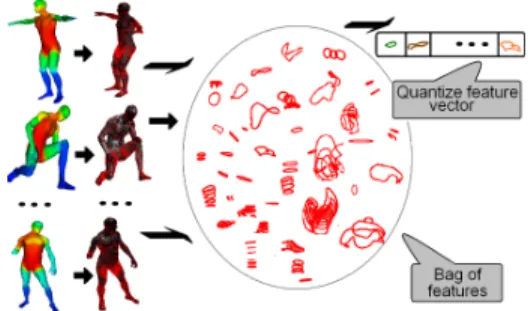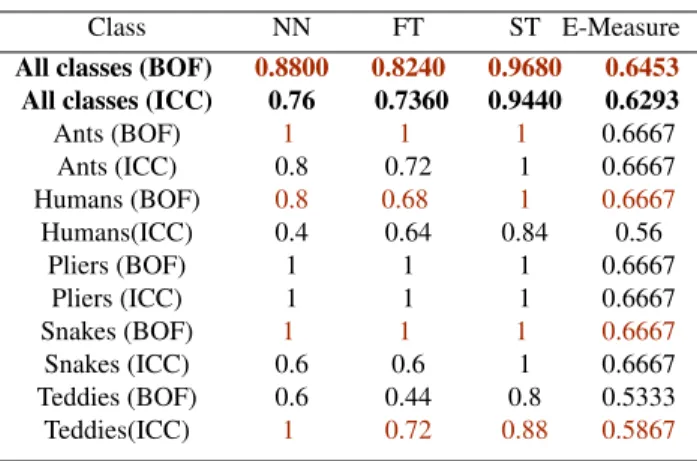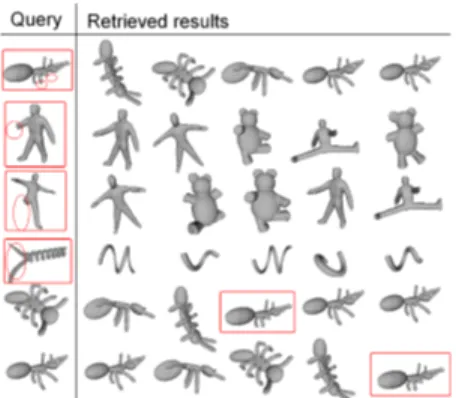HAL Id: hal-00806609
https://hal.archives-ouvertes.fr/hal-00806609
Submitted on 4 Jun 2013
HAL is a multi-disciplinary open access
archive for the deposit and dissemination of
sci-entific research documents, whether they are
pub-lished or not. The documents may come from
teaching and research institutions in France or
abroad, or from public or private research centers.
L’archive ouverte pluridisciplinaire HAL, est
destinée au dépôt et à la diffusion de documents
scientifiques de niveau recherche, publiés ou non,
émanant des établissements d’enseignement et de
recherche français ou étrangers, des laboratoires
publics ou privés.
3D-model retrieval using bag-of-features based on closed
curves
Rachid El Khoury, Jean-Philippe Vandeborre, Mohamed Daoudi
To cite this version:
Rachid El Khoury, Jean-Philippe Vandeborre, Mohamed Daoudi. 3D-model retrieval using
bag-of-features based on closed curves. Eurographics 2013 Workshop on 3D Object Retrieval, May 2013,
Girona, Spain. 3DOR2013 - short paper. �hal-00806609�
Eurographics Workshop on 3D Object Retrieval (2013) S. Biasotti, I. Pratikakis, U. Castellani, and T. Schreck (Editors)
3D-model retrieval using bag-of-features based on closed
curves
Rachid El Khoury, Jean-Philippe Vandeborre, Mohamed Daoudi Institut Mines-Télécom; Télécom Lille1; LIFL (UMR 8022 Lille1/CNRS), France
Abstract
Bag-of-feature technique is a popular approach in areas of computer vision and pattern recognition. Recently, it plays an important role in shape analysis community and especially in 3D-model retrieval. We present our approach for partial 3D-model retrieval using this technique based on closed curves. We define an invariant scalar function on the surface based on the commute-time distance. Our mapping function respects important properties in order to compute robust closed curves. Each scale of our scalar function detects a small region. The form of these regions are encoded in the form of the closed curves. We generate a collection of closed curves from a source point detected automatically. Based on the collection of all closed curves extracted, we construct our bag-of-features. Then we cluster the bag-of-features in the sense in accurate categorization. The centres of classes are defined askeyshapes. This method is particularly interesting in the sense of quantifying the 3D-model by itskeyshapes that are accumulated into an histogram. The results shows the robustness of our method (BOF) compared to a method based on indexed closed curves (ICC) on various 3D-models with different poses. Categories and Subject Descriptors (according to ACM CCS): I.3.3 [Computer Graphics]: Picture/Image Generation—Line and curve generation
1. Introduction
In recent year, a large number of 3D graphics applications use 3D data which grow in numbers and details precision. The evolution of this domain has created the need for a 3D object search engine with a good performance in time con-suming and results. To achieve this idea, and to search a database for 3D-models that are visually similar, we must create a specific discriminant signature. This signature en-code the shape of 3D-models and it should respect the in-variance to rigid and non rigid transformation, the insensi-tivity to noise, the robustness to topology changes, the in-dependence on parameters and handle partial 3D-models for retrieval. Since a few year the creation of a such signature became a challenge for researchers. Several 3D-model in-dexing approaches and shape descriptors have been intro-duced in the literature [TV08]. The development in the field of 3D-model retrieval is still an open question. We present a novel approach based on closed curves using the bag-of-feature technique. The rest of this paper is organized as fol-low. In section2, we discuss the previous work. In section3, we extract feature points, then we use them in section4to define our mapping function. Section5discusses the
bag-of-feature technique using the closed curves extracted as local features. Before concluding, the experiments and results are explored in section6and section7.
2. Related work
Several approaches have been explored for 3D-model re-trieval. Reuter et al. [Reu10] improve the discretization to a higher level of Laplace-Beltrami operator by adding ex-tra nodes on each triangle in the mesh. They use the specex-tra given by the first n eigenvalues as isometric invariance de-scriptor. Mahmoudi and Sapiro [MS08] compare histogram of pairwise using the diffusion distances between all nodes on the mesh. Sun et al. [SOG09] restrict his studies to the temporal domain and compute their signature by observ-ing the evolution of the heat diffusion over time. Rusta-mov [Rus07] creates a descriptor vector from the evaluated eigenfunctions of Laplace-Beltrami operator. Bronstein et al.[BBGO11] compute the remaining heat on each vertex after a scale time t. For scale invariance, they improve the heat kernel signature to scale-invariant heat kernel signa-ture by scaling and shifting using a logarithmic scale-space based on Fourier transform. These works provide
develop-R. El Khoury, J.P. Vandeborre, M. Daoudi / 3D-model retrieval using bag-of-features based on closed curves ment methods for 3D-shape analysis, especially for
non-rigid 3D-shape retrieval and comparison. The bag-of-feature technique is very useful for partial 3D-model retrieval. Liu et al.[LZQ06] present a 3D-shape descriptor and apply it to 3D partial shape retrieval. In their method, a 3D-object is considered as a word histogram obtained by vector quanti-fying Spin Images of the object. Ohbuchi et al. [OOFB08] introduced a view-based method using salient local features. They represent 3D-objects as word histograms derived from the vector quantifying of salient local descriptors extracted on the depth-buffer views captured uniformly around the ob-jects. The main drawback of this technique is that it loses the spatial relation between parts, since it ignores the position of each feature.
3. Feature point extraction
We use the diffusion distance [CLL∗05] to extract feature points. The diffusion distance is the Euclidean distance in the spectral embedding space. We define it using the heat kernels as:
dS(t, x, y) = kK(t, x, ·) − K(t, y, ·)kL2(S) (1)
where K(t, x, y) is the heat kernel and x, y two points defined on the mesh surface S. In a large time variable t, global prop-erties are detected and the farthest two feature points are computed. In a small variable time t, from the farthest two points, we compute the local minimum diffusion distance (vertex with all its level-one neighbours that have a higher value) to detect the other feature points.
4. Definition of our mapping function
We define our mapping function using the commute time distance. The commute-time distance is defined as:
dcS(x, y)2= ∞
∑
i=1 1 λi (ψi(x) − ψi(y))2 (2)Where ψiare the eigenfunctions that correspond to λi
eigen-values of Laplace-Beltrami operator satisfying ∆Sψi= λiψi.
This distance takes into consideration all paths connecting a pair of vertices (x, y) on the mesh [QH07], a small topology change does not affect enormously the results. Based on this distance, we define our mapping function Fmas:
Fm(v) = max(dcS(v,Vi), i = 1..nbVi)) (3)
where Viis the ithfeature point, nbViis the number of feature
points, dcS(v,Vi) is the commute time distance. This
func-tion computes for each vertex v the distance to the nearest feature point where the commute time distance is the high-est. Red to blue colors express the increasing values of the mapping function in the first column of figure1. This func-tion is computed using the eigenfuncfunc-tions and eigenvalues of the Laplace-Beltrami operator. It can be seen as a global smooth scalar function and handles noisy data. For uniform scaling, we normalized the spectrum (eigenvalues) of the
mesh. The mapping function is defined to be dependent only on the structure of the mesh. This makes it robust to isomet-ric transformations.
5. Method presentation
Our approach for 3D-model retrieval is developed following the main steps of the bag-of-feature technique. We start by the training stage illustrated in figure1proceeding with the online stage illustrated in figure2.
Figure 1: Training stage. From left to right: mapping func-tion of the 3D-models, extracfunc-tion of closed curves, the col-lection of all curves to define the bag-of-features and the quantize features vector.
Figure 2: Online stage. From left to right: Extraction of closed curves of a query 3D-model, the vector quantizes the local features into keyshapes that are accumulated into an histogram.
5.1. Training stage
We need to extract local features describing the local re-gion on the 3D-models. For each 3D-model in our database, we compute our mapping function discussed in section4. We generate a collection of closed curves under a scale value of our function from a source vertex detected automat-ically on the surface (the farthest point of all feature points). Each model is described by 25 levels of closed curves in the database. A level could contain more than one curve. Each curve describes a small region of the 3D-model. These closed curves extracted are defined as local features. Local features extracted should be invariant to rigid and non rigid transformations of the 3D-model. Indeed, for each 3D-model
most of these local features are not affected to global varia-tion, even if a part of the 3D-model is missing (see figure3). To define a similarity measure between two curves, we nor-malize them, then we adopt Joshi et al.’s method [JKSJ07] which analyses the shape of the curves such as one curve has to (locally) stretch, compress and bend to match the other. For more information about the feature point extraction and the mapping function computation see [?], for the extraction of closed curves see [EVD12].
The collection of closed curves of all 3D-models are grouped to define our of-features. We clustered our bag-of-features by choosing the most widely used algorithms in computer vision community: k-means implemented in MAT -LAB. We run k-means several times with different number of desired representative vectors and different sets of initial cluster centres. We select the final clustering giving the best results. The centres of these classes are the keyshapes.
Figure 3: A global variation. Even models with missing data in the 3D-models do not affect most of the closed curves extracted as local features
5.2. Online stage
Having a query as a 3D-model, we extract the local features as closed curves. Then, the 3D-model query is represented by its keyshapes that are accumulated into an histogram hav-ing the number of the bins equal to the size of the vocabu-lary. The histogram becomes the features vector of the cor-responding 3D-model.
The features vector obtained defines the number of times a given keyshape appears in that 3D-model query. It is usual to normalize the features vector obtained by the sum of occur-rences of all terms of the considered 3D-model query. The features vector will be used as a descriptor for the compari-son of 3D-models.
6. Experiments on 3D-model retrieval
In this section, we present the experimental results in order to evaluate our approach for 3D-model retrieval. The collec-tion of 3D-models contained in our database are collected from the dataset for SHREC 2010 - Shape Retrieval Contest of Non-rigid 3D-Models. It consists of 25 3D-models which are equally classified into 5 categories (ants, humans, pli-ers, snakes, teddies) based on their semantic meanings. We evaluate our results using the evaluation tool: the Precision
(a) PR plots on all data us-ing the bag-of-feature tech-nique.
(b) PR plots on all data using the indexed closed curves method.
Figure 4: Precision vs Recall plots for the whole dataset.
vs Recall plot, the Nearest Neighbour (NN), First Tier (FT), Second Tier (ST) and the E-measure scores. The E-measure only considers the first 10 retrieved models for every query. Also, we compare the results obtained by the bag-of-feature technique (BOF) based on closed curves, to indexed closed curve method (ICC) presented in [EVD12].
Figure4presents the Precision vs Recall curves for the whole dataset of our bag-of-feature technique and of the in-dexed closed curve method. This figure clearly shows that the bag-of-feature technique outperforms the indexed closed curves method on this database. Indeed, if we look at the re-sults for each class apart of the database presented in table
1, one can notice that the bag-of-features have better results on most of the classes. This is due to the forms of the closed curves. The description of a small region is encoded in the form of the curves. Two 3D-models look similarly, if the repartition of the form of their closed curves are similar. Un-like, the indexed closed curves method which matches two 3D-models by matching their corresponding curves of each level. Also, each level may have more than one curve. Thus, it is not easy to find their corresponding curves. This prob-lem is solved by the definition of the bag-of-feature tech-nique itself.
Table 1: Retrieval statistics using our approach
Class NN FT ST E-Measure
All classes (BOF) 0.8800 0.8240 0.9680 0.6453
All classes (ICC) 0.76 0.7360 0.9440 0.6293
Ants (BOF) 1 1 1 0.6667 Ants (ICC) 0.8 0.72 1 0.6667 Humans (BOF) 0.8 0.68 1 0.6667 Humans(ICC) 0.4 0.64 0.84 0.56 Pliers (BOF) 1 1 1 0.6667 Pliers (ICC) 1 1 1 0.6667 Snakes (BOF) 1 1 1 0.6667 Snakes (ICC) 0.6 0.6 1 0.6667 Teddies (BOF) 0.6 0.44 0.8 0.5333 Teddies(ICC) 1 0.72 0.88 0.5867
R. El Khoury, J.P. Vandeborre, M. Daoudi / 3D-model retrieval using bag-of-features based on closed curves 7. Experiments toward partial 3D-model retrieval
Methods using global descriptors cannot describe partial 3D-models. Our approach shows good results. Indeed, Figure5a
presents the mapping function which remains the same af-ter two legs are cut off, which it leads to closed curves are generated from the same point and the forms of these curves remain the same. Even if a part of a 3D-model is cut off in-cluding the source point, our approach will detect another source point in the centre of the object. Most of the closed curves generated from this new point will not be affected just the first few ones. Since these curves are generated due to a scale value of the mapping function. The scale of the func-tion will vary but the form of these curves remains almost the same. Because our mapping function based on the commute-time distance is defined on the evolution of the heat propa-gated in different time scale in the 3D-models by considering all paths connecting a pair of nodes. The heat propagates in the same manner in the same region and the form of these curves remains unchanged. We also test our approach using a combined objects from our database as it is shown in fig-ure5b. As an example of retrieved results, figure6presents a partial and combined 3D-models used as a query and the top five retrieved results returned by our algorithm. Also we added the partial 3D-model to the database and redo the ex-periments which leads to accurate results.
(a) The mapping function of a 3D-model ant with two of its legs cut off.
(b) Combined 3D-model (pliers and snake) and its mapping function. Figure 5: Partial 3D-models.
Figure 6: Partial 3D-model query retrieval results. First line to third lines present partial 3D-models used as query the forth present a combined 3D-models (plier and snake). The last two lines show partial 3D-models added to the database.
8. Conclusion
In this paper, we presented a novel approach for 3D-model retrieval based on closed curves extracted as local features. A scale of our mapping function detects a region. The form of these regions are encoded in the form of the closed curves. The collection of the closed curves of the whole database constitutes our features. We clustered the bag-of-features and the centres of classes are defined as keyshapes. We demonstrated the effectiveness of our approach on two sets of experiments. First set of experiments are made to evaluate our approach for 3D-model retrieval and we com-pared our results to indexed closed curve approach presented in [EVD12]. The second set of experiments are made to val-idate our approach towards partial 3D-model retrieval.
References
[BBGO11] BRONSTEINA. M., BRONSTEIN M. M., GUIBAS
L. J., OVSJANIKOVM.: Shape google: Geometric words and expressions for invariant shape retrieval. ACM Trans. Graph. 30 (February 2011).1
[CLL∗05] COIFMANR. R., LAFONS., LEEA. B., MAGGIONI
M., NADLERB., WARNERF., ZUCKERS. W.: Geometric dif-fusions as a tool for harmonic analysis and structure definition of data: Diffusion maps. vol. 102, pp. 7426–7431.2
[EVD12] ELKHOURYR., VANDEBORREJ.-P., DAOUDIM.: In-dexed heat curves for 3d-model retrieval. 21st International Con-ference on Pattern Recognition(Nov 2012). Japan.3,4
[JKSJ07] JOSHI S., KLASSEN E., SRIVASTAVA A., JERMYN
I.: Removing shape-preserving transformations in square-root elastic framework for shape analysis of curves. In EMMCVPR (2007).3
[LZQ06] LIUY., ZHA H., QINH.: Shape topics: A compact representation and new algorithms for 3d partial shape retrieval. In In Proceedings of IEEE Conference on Computer Vision and Pattern Recognition (CVPR)(2006).2
[MS08] MAHMOUDIM., SAPIROG.: Three-dimensional point cloud recognition via distributions of geometric distances. In IEEE Conference on Computer Vision and Pattern Recognition Workshops. CVPRW.(june 2008), pp. 1 –8.1
[OOFB08] OHBUCHIR., OSADAK., FURUYAT., BANNO T.: Salient local visual features for shape-based 3d model retrieval. In International Conference on Shape Modeling and Applica-tions (SMI)(2008).2
[QH07] QIUH., HANCOCKE. R.: Clustering and embedding using commute times. IEEE Trans. Pattern Anal. Mach. Intell. 29, 11 (Nov. 2007), 1873–1890.2
[Reu10] REUTERM.: Hierarchical shape segmentation and reg-istration via topological features of laplace-beltrami eigenfunc-tions. International Journal of Computer Vision 89 (2010).1
[Rus07] RUSTAMOVR. M.: Laplace-beltrami eigenfunctions for deformation invariant shape representation. In Eurographics symposium on Geometry processing(2007).1
[SOG09] SUNJ., OVSJANIKOVM., GUIBASL.: A concise and provably informative multi-scale signature based on heat diffu-sion. Computer Graphics Forum 28, 5 (2009), 1383–1392.1
[TV08] TANGELDERJ. W., VELTKAMPR. C.: A survey of con-tent based 3d shape retrieval methods. Multimedia Tools Appl. 39, 3 (Sept. 2008), 441–471.1


